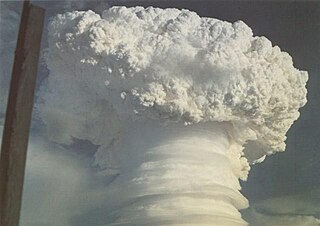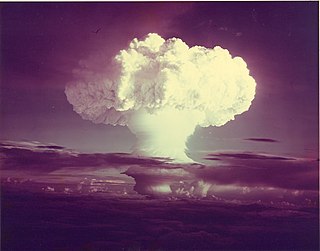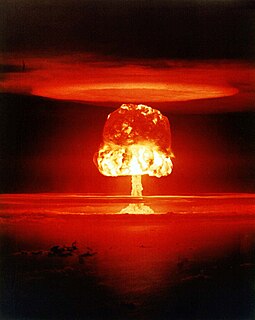 W
WEnewetak Atoll is a large coral atoll of 40 islands in the Pacific Ocean and with its 664 people forms a legislative district of the Ralik Chain of the Marshall Islands. With a land area total less than 5.85 square kilometres (2.26 sq mi), it is no higher than 5 meters (16.4 ft) and surrounds a deep central lagoon, 80 kilometres (50 mi) in circumference. It is the second-westernmost atoll of the Ralik Chain and is 305 kilometres (190 mi) west from Bikini Atoll.
 W
WOperation Greenhouse was the fifth American nuclear test series, the second conducted in 1951 and the first to test principles that would lead to developing thermonuclear weapons. Conducted at the new Pacific Proving Ground, on islands of the Enewetak Atoll, all of the devices were mounted in large steel towers, to simulate air bursts. This series of nuclear weapons tests was preceded by Operation Ranger and succeeded by Operation Buster-Jangle.
 W
WGreenhouse Item was an American nuclear test conducted on May 25, 1951, as part of Operation Greenhouse at the Pacific Proving Ground, specifically on the island of Engebi in the Eniwetok Atoll in the Central Pacific Ocean. This test explosion was the first test of a boosted fission weapon.
 W
WOperation Hardtack I was a series of 35 nuclear tests conducted by the United States from April 28 to August 18 in 1958 at the Pacific Proving Grounds. At the time of testing, the Operation Hardtack I test series included more nuclear detonations than the total of all prior nuclear explosions in the Pacific Ocean. These tests followed the Project 58/58A series, which occurred from 1957 December 6 to 1958, March 14, and preceded the Operation Argus series, which took place in 1958 from August 27 to September 6.
 W
WOperation Ivy was the eighth series of American nuclear tests, coming after Tumbler-Snapper and before Upshot–Knothole. The two explosions were staged in late 1952 at Eniwetok Atoll in the Pacific Proving Ground in the Marshall Islands.
 W
WIvy King was the largest pure-fission nuclear bomb ever tested by the United States. The bomb was tested during the Truman administration as part of Operation Ivy. This series of tests involved the development of very powerful nuclear weapons in response to the nuclear weapons program of the Soviet Union.
 W
WIvy Mike was the codename given to the first full-scale test of a thermonuclear device, in which part of the explosive yield comes from nuclear fusion. Ivy Mike was detonated on November 1, 1952, by the United States on the island of Elugelab in Enewetak Atoll, in the now independent island nation of the Marshall Islands, as part of Operation Ivy. It was the first full test of the Teller–Ulam design, a staged fusion device.
 W
WOperation Castle was a United States series of high-yield (high-energy) nuclear tests by Joint Task Force 7 (JTF-7) at Bikini Atoll beginning in March 1954. It followed Operation Upshot–Knothole and preceded Operation Teapot.
 W
WOperation Redwing was a United States series of 17 nuclear test detonations from May to July 1956. They were conducted at Bikini and Enewetak atolls by Joint Task Force 7 (JTF7). The entire operation followed Project 56 and preceded Project 57. The primary intention was to test new, second-generation thermonuclear weapons. Also tested were fission devices intended to be used as primaries for thermonuclear weapons, and small tactical weapons for air defense. Redwing demonstrated the first United States airdrop of a deliverable hydrogen bomb during test Cherokee. Because the yields for many tests at Operation Castle in 1954 were dramatically higher than predictions, Redwing was conducted using an "energy budget": There were limits to the total amount of energy released, and the amount of fission yield was also strictly controlled. Fission, primarily "fast" fission of the natural uranium tamper surrounding the fusion capsule, greatly increases the yield of thermonuclear devices, and constitutes the great majority of the fallout, as nuclear fusion is a relatively clean reaction.
 W
WOperation Sandstone was a series of nuclear weapon tests in 1948. It was the third series of American tests, following Trinity in 1945 and Crossroads in 1946, and preceding Ranger. Like the Crossroads tests, the Sandstone tests were carried out at the Pacific Proving Grounds, although at Enewetak Atoll rather than Bikini Atoll. They differed from Crossroads in that they were conducted by the Atomic Energy Commission, with the armed forces having only a supporting role. The purpose of the Sandstone tests was also different: they were primarily tests of new bomb designs rather than of the effects of nuclear weapons. Three tests were carried out in April and May 1948 by Joint Task Force 7, with a work force of 10,366 personnel, of whom 9,890 were military.